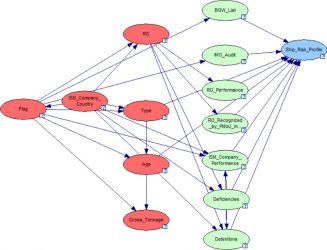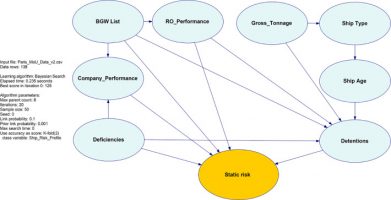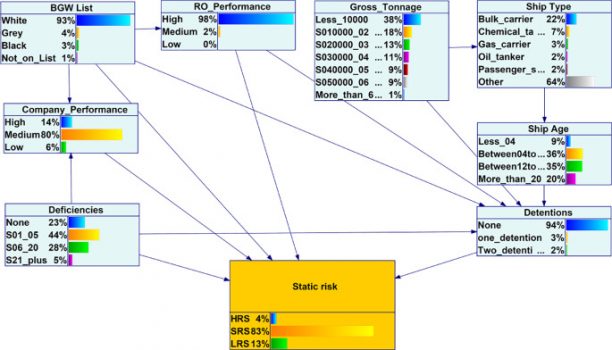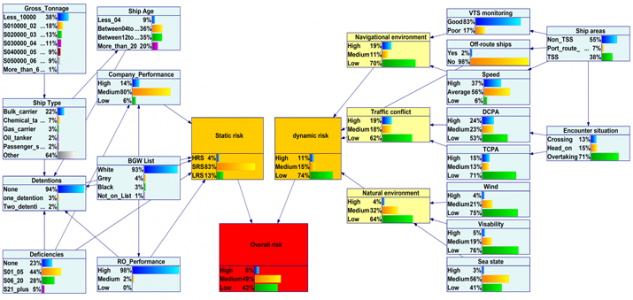Task 3: development of a dynamic risk index of individual ships
In particular, under the scope of Task 3, a judgmental expert-based process has been developed to assess the ship collision risk using the ELECTRE Tri-nC multiple criteria outranking method (Silveira et al. 2021). The approach first establishes a set of criteria deemed important by navigation experts, all of them experienced nautical officers, to assess the collision risk between two ships in open waters. The model considers criteria related to the ships’ motion, but also to ship characteristics and environmental factors. A deck of cards-based method is then used to determine the weights of each criterion, according to the experts’ preferences. Finally, risk categories chosen by the experts are characterized in terms of multiple reference scenarios, also provided by the experts, and the ELECTRE Tri-nC method is used to assign validation scenarios to the risk categories.
The model has been validated and then applied to an encounter scenario between two vessels to monitor collision risk as the situation evolves and to assess the effect of possible course alterations on the assigned risk category, both at the moment of the collision avoidance action and subsequently, until the encounter situation is resolved and the distance between ships starts increasing. This application demonstrated the possible use of the model as an aid for real-time collision risk assessment and collision avoidance, both on board ships and at VTS centres.
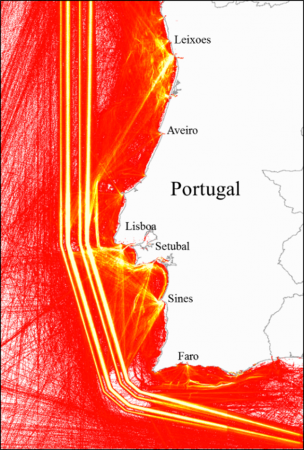
Possible future developments include expanding the model to classify the risk of collision when more than two ships are involved, as well as testing the robustness to expert subjectivity by validating the results using an enlarged and different set of experts that have not participated in the development of the model.
Also, the model can be combined within a probabilistic framework with other models that cover other risk components such as the static risk of the vessels involved in an encounter (e.g., age, flag, records of deficiencies and/or Port State Control detentions), as suggested by Dinis et al. (2020), or the eventual consequences of a collision (e.g. type and quantity of cargo, quantity of fuel, number of crew and/or passengers).
Still under the scope of Task 3, a probabilistic framework for assessing the risk of ships based on a hybrid approach and multiple data sources has been developed (Qing et al. 2021) . A Bayes-based network learning approach uses data from the New Inspection Regime of the Paris MoU on Port State Control to characterize the relationships among risk parameters and uses these parameters to evaluate the ship static risk. Other data sources are used to develop a Bayesian Network model to assess the dynamic risk of the ship. The data is aggregated by Bayesian Network and Evidential Reasoning approaches to evaluate the overall risk of ships in coastal waters. The objective of the study is to develop a model to assess the risk of an individual ship by considering its static risk profile and the geographical-dependent risk factors related to the characteristics of the maritime traffic flow and other local characteristics that influence the navigational risk of the ship.
The framework adopts Ship Risk Profile inspection data, AIS data and several other data sources to evaluate the overall risk of a ship. Following the framework, the Bayesian Search algorithm is first applied to ship inspection data to develop a risk model that evaluates the ship static risk reflecting the main influence of the static risk factors adopted in the Ship Risk Profile system. Then, AIS data provides the maritime traffic flow characteristics in the study area and the means for defining specific RIFs related to the local maritime traffic and navigational conditions, which affect the dynamic risk of the ship. The static and dynamic risk models are then aggregated by BN and ER approaches to evaluate the ship overall risk and to validate the results through various model validity methods.
To provide empirical evidence for the use of the proposed approach, the maritime traffic off the continental coast of Portugal as well as inspection data from the Portuguese Port State Control are used to develop a risk assessment model and to analyze critical situations in the study waters.
The results show that the integrated approach can assess the overall risk of a ship based on multiple data sources, providing empirical evidence of using multiple data sources in risk analysis applications. Moreover, the developed model identifies the most critical circumstances and the key impact factors in the study waters, which can support decisions on risk prevention and mitigation measures and local maritime traffic management.

